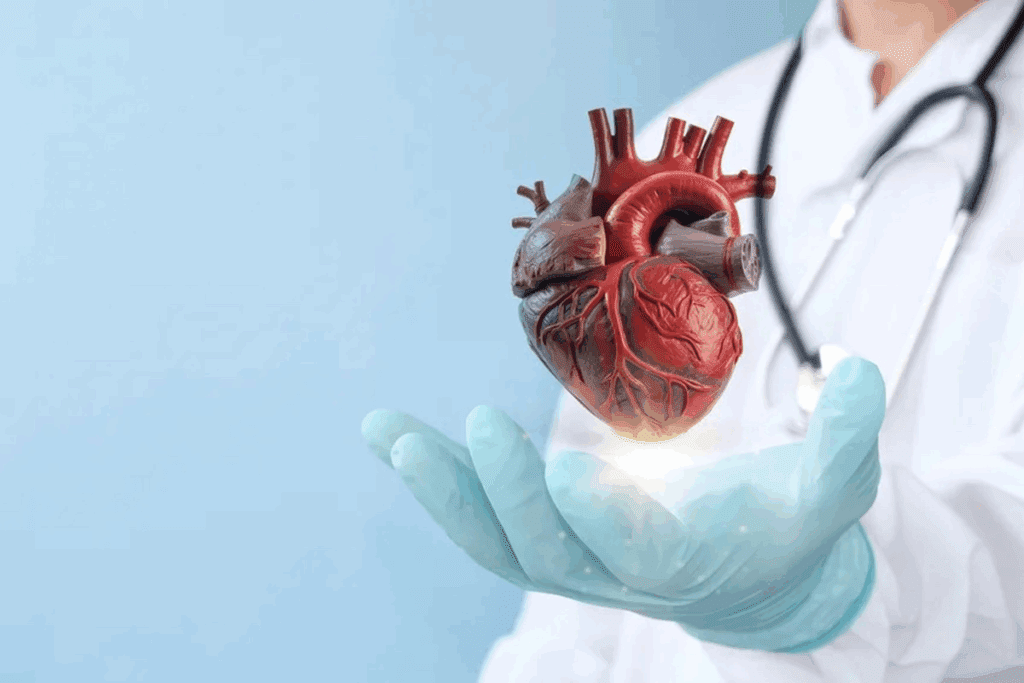
Cardiac emergencies are life-threatening. Quick action and trusted care can save lives. The ‘widowmaker’ condition is one such emergency that requires immediate medical help.
The left anterior descending (LAD) artery is key for heart blood supply. A blockage here can cause a deadly heart attack. It’s vital to know the risks of the ‘widow maker’.
At Liv Hospital, we focus on patient care. We offer top-notch expertise in heart health. Our team is ready to help international patients with advanced medical treatments.

A widowmaker heart attack is a serious heart emergency. It happens when the LAD artery is completely blocked. This artery is key because it supplies a big part of the heart with blood, oxygen, and nutrients.
This blockage can cause severe damage or even death if not treated quickly. The term “widowmaker” shows how deadly this condition is. It can suddenly take a loved one away from family and spouses.
The widowmaker heart attack is caused by a 100% blockage of the LAD artery. This is a serious situation that needs immediate medical help. The blockage stops blood from reaching a big part of the heart, causing a lot of damage.
This condition is dangerous because it can happen suddenly and without warning. Unlike other heart problems that may develop slowly, a widowmaker heart attack can strike fast. This makes it very risky.
This condition is feared because of its high death rate if not treated fast. The LAD artery feeds 45-55% of the left ventricle. This is a big part of the heart’s pumping chamber. A blockage here can cause a huge heart attack, leading to a lot of damage or even cardiac arrest.
The fear of the widowmaker heart attack also comes from its ability to strike without warning. Many people who have a widowmaker heart attack may not have known they were at risk. This makes it a sneaky and scary condition.
It’s important for both doctors and the public to understand the widowmaker heart problem. By knowing the risks and symptoms, we can try to prevent these heart attacks. We can also work to improve outcomes for those who do have them.

The heart’s blood supply system is key to its survival and function. The coronary arteries carry oxygen-rich blood to the heart muscle. This lets the heart pump blood well throughout the body.
The heart needs oxygen and nutrients to work right. It gets these through the coronary circulation. This includes arteries, veins, and capillaries.
The coronary arteries start from the aorta and branch into smaller ones. These smaller arteries feed different heart parts.
The coronary circulation is vital. It gives the heart muscle the oxygen and nutrients it needs. Without it, the heart can’t function, causing serious health problems.
The main coronary vessels are the Left Main Coronary Artery (LMCA), the Left Anterior Descending (LAD) artery, the Left Circumflex Artery (LCx), and the Right Coronary Artery (RCA). Each vessel supplies specific heart areas.
Knowing the coronary arteries’ anatomy is critical for heart health. This complex network ensures the heart muscle gets the blood it needs to work well.
The “widow maker” is a term in cardiology for a specific artery. When blocked, it can cause severe heart damage. This artery is key for blood supply to the heart, linked to high death rates.
The Left Anterior Descending (LAD) coronary artery is known as the “widow maker.” It’s a major branch of the left coronary artery. It supplies blood to a big part of the heart’s left ventricle.
This artery runs down the heart’s front, earning its name. It’s essential for the heart’s function.
The LAD artery’s blood supply is vast. A blockage can cause a massive heart attack. This often results in serious damage or death.
The LAD artery got its “widow maker” name because of severe heart attacks. These attacks can suddenly leave a spouse a widow. The term highlights the artery’s critical role and the deadly risk of its blockage.
To grasp the LAD artery’s importance, let’s look at its role in the heart’s blood supply:
| Artery | Area Supplied | Consequence of Blockage |
| LAD | Major portion of the left ventricle | Large anterior wall infarct, potentially fatal |
| Left Circumflex | Lateral and posterior walls of the left ventricle | Varies; can cause significant damage |
| Right Coronary | Right ventricle, parts of the left ventricle | Can cause inferior wall infarct |
The table shows the different coronary arteries and their impact. The LAD artery’s extensive supply to the left ventricle makes it very important.
It’s vital to understand the LAD artery’s role and its blockage signs. The “widow maker” nickname warns of the dangers of ignoring heart health.
The left anterior descending artery is key to the heart’s blood flow. It keeps the left ventricle healthy. This ventricle pumps blood all over the body.
The LAD artery is in the anterior interventricular sulcus. This groove is on the heart’s surface, between the left and right ventricles. It lets the LAD reach a big part of the heart muscle. The anterior interventricular sulcus is a path for the LAD. It helps deliver oxygen and nutrients to the heart’s important areas.
The LAD artery feeds 45-55% of the left ventricle. This makes it very important for the heart’s blood supply. The left ventricle is the main pumping chamber. The LAD’s blood supply is key for the heart to work right.
Any blockage in the LAD can cause serious heart damage. This is often called a “widowmaker” heart attack. We know how vital the LAD artery is for heart health. Knowing where it is and what it does helps prevent and treat heart problems.
In cardiology, “widowmaker” is a term that means a lot. It refers to a blockage in the Left Anterior Descending (LAD) artery. This artery is key because it supplies blood to the heart.
The term “widowmaker” comes from the high death rate linked to LAD artery blockages. Back then, a blockage in this artery often meant death, leaving many spouses widowed. Today, the term warns of the severe danger of such a blockage.
Doctors use “widowmaker” to stress how vital the artery is. It shows how serious a blockage can be. It also emphasizes the need for quick medical help if a blockage is suspected.
The term “widowmaker” is linked to a 100% blockage of the LAD artery. This can cause a huge heart attack. The LAD artery is important for the left ventricle, which pumps blood.
A complete blockage can harm the heart muscle a lot. This can lead to severe heart failure or even death. Knowing about “widowmaker” is key for doctors and patients.
“Widowmaker” is more than just a term. It shows how serious a blockage in the LAD artery is. It teaches us about the importance of heart health and the need for quick action during a heart attack.
When the LAD artery gets completely blocked, it’s very bad. A 100% blockage in this key artery can cause a huge heart attack. This is often called a “widowmaker” because it’s so deadly if not treated fast.
A complete blockage of the LAD artery happens when a blood clot forms on top of plaque. This is called thrombosis. The blockage stops oxygen-rich blood from getting to a big part of the heart muscle. This leads to quick cell death and damage.
Many things can cause a complete LAD occlusion. These include a burst atherosclerotic plaque and a blood clot. Things like high blood pressure, smoking, or high cholesterol can start this process.
The damage from a 100% LAD occlusion happens very fast. The heart muscle starts to lack oxygen and nutrients right away. Within 15-30 minutes, a lot of damage can happen, and it gets worse over time.
The fast damage shows how urgent medical help is. Quick treatment, like catheterization and stenting, can greatly improve chances and lower death rates.
Knowing the signs of a widowmaker heart attack can save lives. This type of heart attack happens when the left anterior descending (LAD) artery is completely blocked. This artery is key for blood to reach a big part of the heart.
The symptoms of a widowmaker heart attack are intense and sudden. Common warning signs include:
These symptoms can come on without warning and may be more intense than a regular heart attack. Some people might not show any symptoms or might have mild ones that seem not serious.
If you or someone else is showing symptoms of a widowmaker heart attack, act fast. Waiting too long can cause serious heart damage or even death. Call emergency services right away if you think it’s a heart attack.
Emergency care is vital because:
When you get to the hospital, doctors will quickly check your condition and start treatment. This might include procedures like catheterization and stenting to get blood flowing to the heart again.
Knowing the signs and acting fast can be a lifesaver for a widowmaker heart attack.
It’s vital to find blockages in the Left Anterior Descending (LAD) artery quickly. This artery is key for blood flow to the heart. A blockage here can cause serious heart problems.
Today, we have many tools to see the LAD artery and find blockages early. These tools help doctors spot risks and plan the best treatment.
Some important tests for finding LAD blockages are:
Seeing the LAD artery is key to finding blockages. New imaging methods give clear views of the arteries. This helps doctors understand and measure blockages.
| Diagnostic Test | Description | Advantages |
| Coronary Angiography | Involves injecting contrast dye into the coronary arteries to visualize blockages | Provides detailed images of coronary arteries, allowing for precise diagnosis |
| CT Coronary Angiography | Non-invasive CT scan that images the coronary arteries | Less invasive than traditional angiography, quick results |
| Cardiac MRI | Uses magnetic fields to create detailed images of the heart | No radiation, provides complete heart function assessment |
Using these advanced tests, doctors can see the LAD artery and find blockages. Finding problems early is key to avoiding serious heart issues and helping patients get better.
The widowmaker heart attack is very dangerous and needs quick action. It happens when the left anterior descending (LAD) artery gets blocked. This can cause a lot of damage to the heart if not treated fast.
Acting fast is key when a widowmaker heart attack happens. Call emergency medical services (EMS) right away if you have severe chest pain, trouble breathing, or feel faint. At the hospital, doctors will quickly check you with an electrocardiogram (ECG) to see if you’re having a heart attack and where the blockage is.
We focus on getting blood flowing to the heart again. This includes giving aspirin and other antiplatelet medications to stop more clots. We also use oxygen therapy to help the heart work less hard.
Emergency catheterization and stenting are key treatments for a widowmaker heart attack. This method is less invasive. A catheter is put through an artery in the leg or arm to reach the blocked LAD artery. Then, a stent is placed to keep the artery open, helping blood flow to the heart.
| Procedure | Description | Benefits |
| Catheterization | Insertion of a catheter to the blocked artery | Minimally invasive, quick recovery |
| Stenting | Placement of a stent to keep the artery open | Restores blood flow, reduces risk of further blockage |
In some cases, surgical bypass might be needed. This involves making a new path for blood to flow around the blocked area. It’s more invasive than catheterization but can save lives in some cases.
We talk about the risks and benefits of each option with the patient and their family. We make sure the treatment chosen fits their needs and medical history.
To prevent a Widowmaker heart attack, it’s key to know and manage risk factors. A Widowmaker heart attack happens when the Left Anterior Descending (LAD) artery is blocked. This causes serious damage to the heart muscle. Knowing these risks helps us protect our heart health.
Some people are more likely to have a Widowmaker heart attack. These include those with high blood pressure, high cholesterol, diabetes, and smokers. Family history of heart disease also matters.
Other risk factors include being overweight, not being active, and eating too much saturated fat and sodium. Men are usually at higher risk than women, as they get older. Knowing these risks is the first step to prevent it.
Preventing a Widowmaker heart attack means making big lifestyle changes and managing health issues. Eating healthy foods like fruits, vegetables, and whole grains is important. So is staying active.
By taking these proactive measures, we can lower our risk of a Widowmaker heart attack. Regular health check-ups are also key. They help us keep an eye on our heart health and adjust our prevention plans as needed.
Recent years have brought big changes in treating widowmaker heart attacks. These changes have made a big difference in how we help patients. Now, more people survive and live better lives after these attacks.
The way we treat heart attacks has gotten a lot better. New stents are stronger and can help prevent arteries from getting narrow again. This has made treatments safer and more effective.
New catheter technologies are also making procedures safer. They help doctors avoid damaging arteries. Plus, better imaging tools help doctors make more accurate diagnoses and treatments.
Technology has been key in helping more people survive widowmaker heart attacks. Tools like artificial intelligence help doctors make quicker and more accurate diagnoses. This means patients get the right treatment faster.
Telemedicine has also made a big difference. It lets doctors in remote areas give patients the care they need. Wearable devices and remote monitoring keep an eye on patients’ health, helping doctors act fast if needed.
There’s also been progress in mechanical circulatory support devices. These, like ventricular assist devices (VADs), help patients with severe heart failure. New VAD technology makes these devices more reliable and easier to use, giving patients new hope.
It’s key to know about the widowmaker heart problem and its link to the LAD artery for heart health. We’ve looked into how serious this issue is, the coronary arteries’ anatomy, and the LAD artery’s role.
The widowmaker heart problem is a full blockage of the LAD artery. It’s a serious emergency that needs quick action. Knowing the symptoms and risk factors can help a lot.
We talked about the need for fast diagnosis and treatment. This includes emergency care and long-term prevention. Knowing about the widowmaker heart problem helps protect heart health and lowers the risk of serious heart issues.
As we keep improving in heart care, understanding the widowmaker heart problem is vital. Our focus on education and prevention helps people make smart choices for their heart health. This leads to better health outcomes.
The widowmaker heart problem is a blockage in the left anterior descending (LAD) artery. This can cause a fatal heart attack if not treated quickly.
The left anterior descending (LAD) coronary artery is called the “widow maker.” It’s critical for the heart’s blood supply and carries a high risk of death.
The LAD artery runs along the anterior interventricular sulcus. This is a groove on the heart’s front, separating the left and right ventricles.
The LAD artery supplies about 45-55% of the left ventricle. This makes it very important for the heart’s function.
In cardiology, “widowmaker” means a blockage in the LAD artery is very dangerous. It can lead to death, leaving a spouse a widow.
A 100% blockage in the LAD artery happens when a blood clot or plaque blocks the artery completely. This cuts off blood flow to the heart muscle.
Symptoms of a widowmaker heart attack include severe chest pain and shortness of breath. Dizziness and fatigue can also occur. Some people may not show any symptoms.
Imaging tests like coronary angiography and cardiac CT scans can diagnose a blockage in the LAD artery. Stress tests are also used.
Treatments for a widowmaker heart attack include emergency catheterization and stenting. Surgical bypass grafting is also an option. These aim to restore blood flow to the heart.
People with heart disease, high blood pressure, and high cholesterol are at high risk. Other cardiovascular risk factors also increase the risk.
Preventive measures include a healthy lifestyle and managing health conditions. Regular medical check-ups are also important to monitor heart health.
New treatments include improved stenting techniques and advanced imaging technologies. These are part of the latest advances in cardiac intervention.
National Center for Biotechnology Information. (2025). What Is the Widowmaker Heart Problem and Which.
Subscribe to our e-newsletter to stay informed about the latest innovations in the world of health and exclusive offers!
WhatsApp us